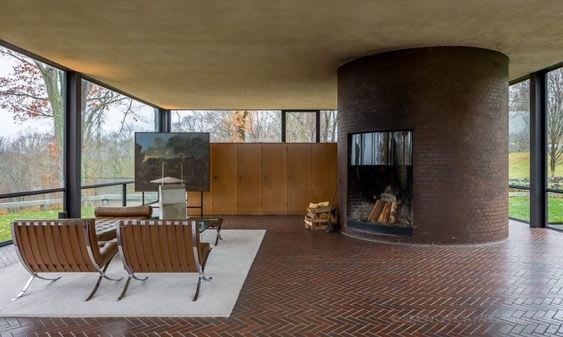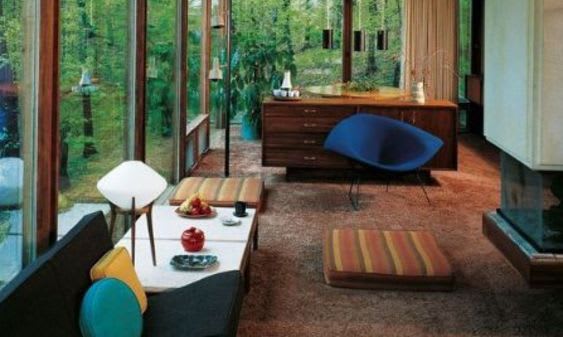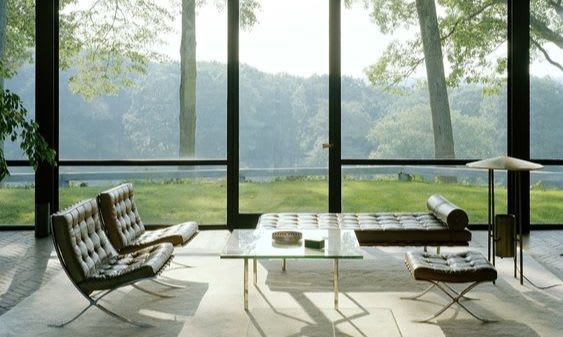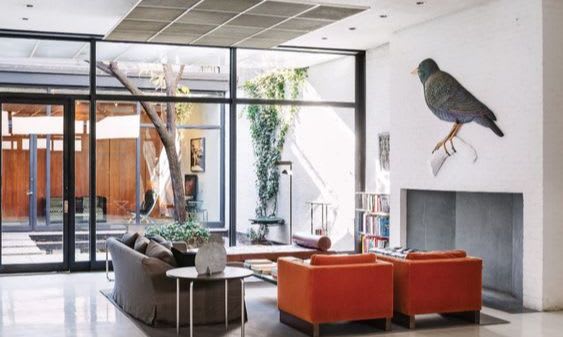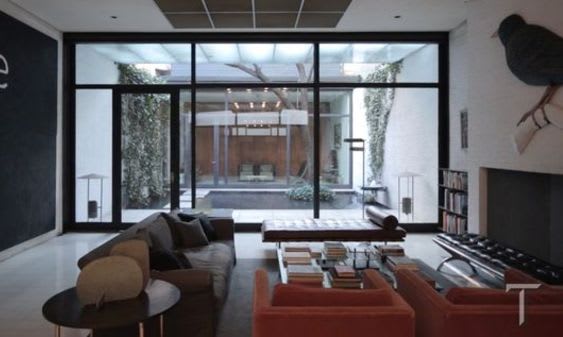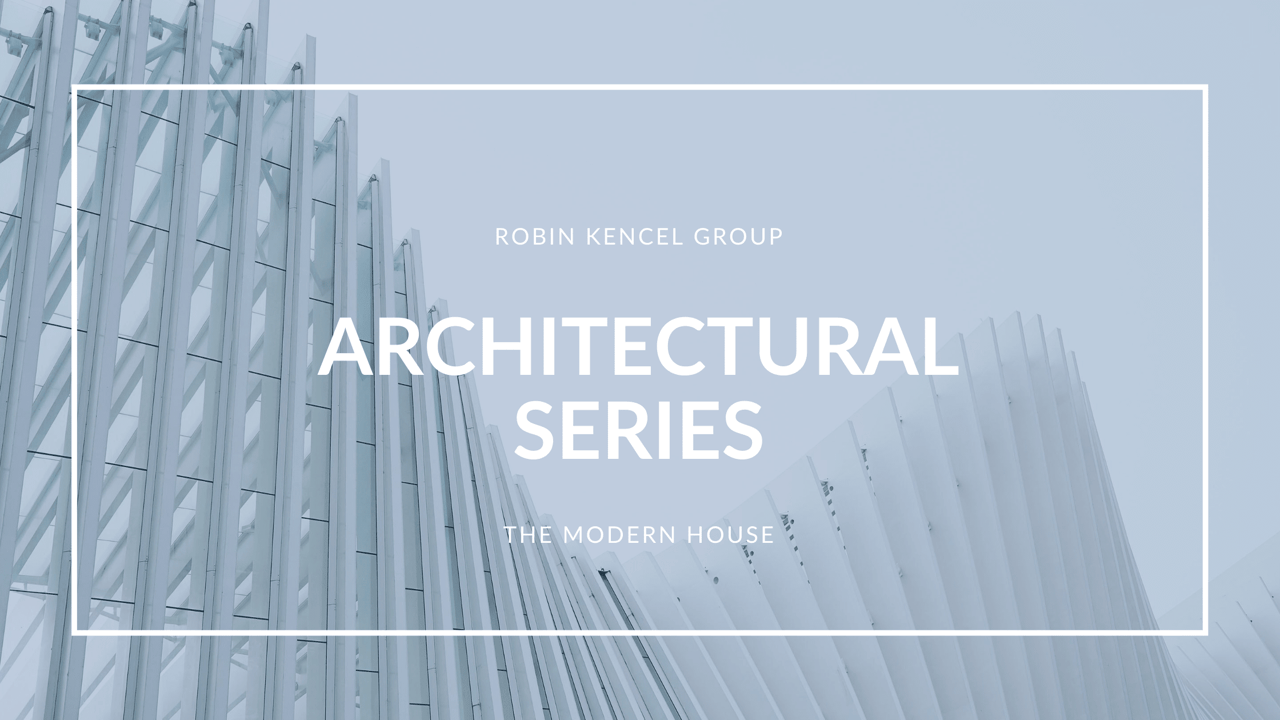What Is a Modern House?
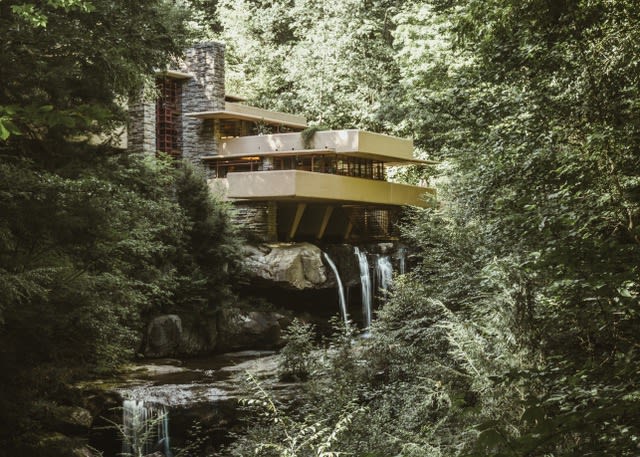
A truly Modern, also termed Mid-Century, house is organized to serve its occupants’ needs, rather than conforming to established conventions. What’s inside takes precedence over the external imagery that is so dominant in traditional styles. Its layout responds to sources of daylight, appealing views, and access to outdoor spaces. The result is usually a house of irregular configuration, with no symbolic front façade.
Modern houses are sometimes built on “difficult” sites– with prominent rock ledges, steep slopes, streambeds crossing them. Sites not suitable for classically laid out designs have been accepted as creative challenges for many Modern architects. And some houses, responding to such sites, have an upside-down organization on two floors, with living spaces above, bedrooms below.
Modern’s Origins
Modern architecture originated around the dawn of the 20th Century as both an embodiment of the evolving technology and the rejection of historical precedent. The latest structural systems were to be organized with geometrical precision, unencumbered by ornament. The defeat of three obsolescent European empires in World War I gave added inspiration to the movement. In the 1920s, the expanded support for Modern design accompanied the widespread appearance of non-objective art, short skirts, and jazz bands, along with the concert-hall music of Shostakovich and Schoenberg.
The design of Modern houses in America evolved from two distinct sources:
- Appearing around 1900 and proliferated through the 1950s were houses designed by the great American architect, Frank Lloyd Wright and some of his colleagues. They typically have brick walls and exposed wood structural members supporting low-pitched roofs. Some 150 Wright-designed houses were built all over the United States, and most still exist. An exceptional and well-preserved cluster of houses designed by or inspired by Wright can be seen in Usonia, a mid-20th-century enclave in Westchester County, New York.
- A different Modernism developed in Europe in the 1920s, mainly identified with the Bauhaus school of design in Germany, which had faculty and students from all over Europe. While that version of Modernism – often identified as International Style -- was inspired by Wright’s work, it dispensed with the kind of visual enrichment he developed out of construction details, favoring instead large stretches of blank white wall and clear glass, topped with flat roofs. Bauhaus teachers Walter Gropius, Marcel Breuer, and Ludwig Mies van der Rohe emigrated to the U.S. in the late 1930s and shared their design concepts with a generation of young Americans. Examples of this Bauhaus-inspired architecture are widely distributed across the nation and continue to be built right up to the present. Many prime examples can be found in New Canaan, Connecticut, where several noted Modernists lived and practiced architecture.
Varieties of Modern Houses
There is a great deal of variety among Modern houses as among houses of any style but they are likely to embody most of the following characteristics:
- Expanses of continuous flat wall juxtaposed with areas of floor-to-ceiling glass sometimes horizontal strips of window as well almost never windows of traditional proportions.
- No decorative treatment of interior or exterior walls, most often surfaced with white plaster or stucco or clad in natural wood, .
- No ornamental molding or trim where surfaces meet – and only the most minimal detail around door and window openings.
- Exposed structural members – columns, beams, or trusses – no larger than required for support.
- A prominent play of basic geometrical forms – rectangular, triangular, or circular.
- Flat or of low-pitched roofs that often project out to shade windows or shelter outdoor spaces.
Interior planning details found in many Modern houses include:
- Kitchens, even at midcentury, only partially enclosed by cabinets, often with pass-through counters.
- Extensive built-in seating, shelving, and cabinets in all parts of the house.
- Typical 20th-C closets replaced by storage walls extending across the sides of rooms or along corridors.
- Floors of natural slate, unglazed ceramic or synthetic tile, as well as the hardwood typical of other houses.
- Equipment for lighting systems – direct and indirect -- built into ceilings and other architectural surfaces.
Modern Mixes
The Modern houses that rose across the US from the 1940s through the 1960s – often called Midcentury Modern showed some adaptations of earlier regional American traditions. In the Northeast, for example, rough stone construction appeared in massive walls and chimneys, where earlier purer Modern design might have relied on smoothly stuccoed walls and minimal chimneys. In the Northwest, Modern houses were more likely to have peaked roofs and large areas of wood cladding. In the Southwest, they might feature regional elements such “ramadas,” latticed canopies that moderate the desert sun.
In other instances, aspects of Modern design were mixed with traditional characteristics in houses that may be identified as Contemporary. Some of these have stretches of uninterrupted wall alternating with areas if glass in the Modern manner applied to more traditional peaked-roof house forms. Large areas of floor-to-ceiling glass appear as well in a variety of sprawling one-story Ranch-style houses.
While most Americans live in houses of traditional design, we are all influenced by Modern architecture, and those who choose to live in Modern houses enjoy the exceptional environmental experiences they can offer.
Good, Better, Best
If you are a typical buyer, you may be a bit overwhelmed by the house hunting process. It may be easy to decide, for instance, what town you want to live in, but determining whether a house is “good” for you may be elusive if you do not have experience or knowledge in design or construction. Once you find a place you’re excited about, you may want to consider bringing in an architect or decorator to help you assess a home from the standpoint of function and design. A building inspector and/or contractor can evaluate the quality of construction, mechanicals, roof, windows, and other aspects.
Some areas for you to think about as you look at a house:
- Relationship of house to its environment: Is the house well sited on its property? Does its orientation take advantage of the sun’s movement? How is the quality of natural light in its rooms? Do adjoining houses and properties relate well this house?
- Approach and arrival: How is the house situated in relationship to the main road, and is that road busy, quiet. Is the property on a corner, for instance, or at the end of street? Is the entry route clear for visitors, and does it present a pleasing prospect to them? Once inside, is there a good space to greet them? And how about alternative entrances for family, supplies, etc.?
- Interior spaces: Would the floor plan work for you? Would you feel comfortable with the rooms you would use most? Do the rooms have good natural light? Do they lend themselves to good furniture layout? (A decorator’s judgment might be helpful here.)
- Materials and workmanship: Are materials, indoors and out, in good condition? Are they good materials as backdrops for your activities? If not, could they be readily refinished or replaced?
- Outdoor spaces: What is important to you in outdoor spaces and how does this property measure up? Do the house and site allow for additional outdoor spaces you might want, such as a pool or particular gardens?
Philip Johnson’s Glass House Is Located in New Canaan Ct and Open to the Public
